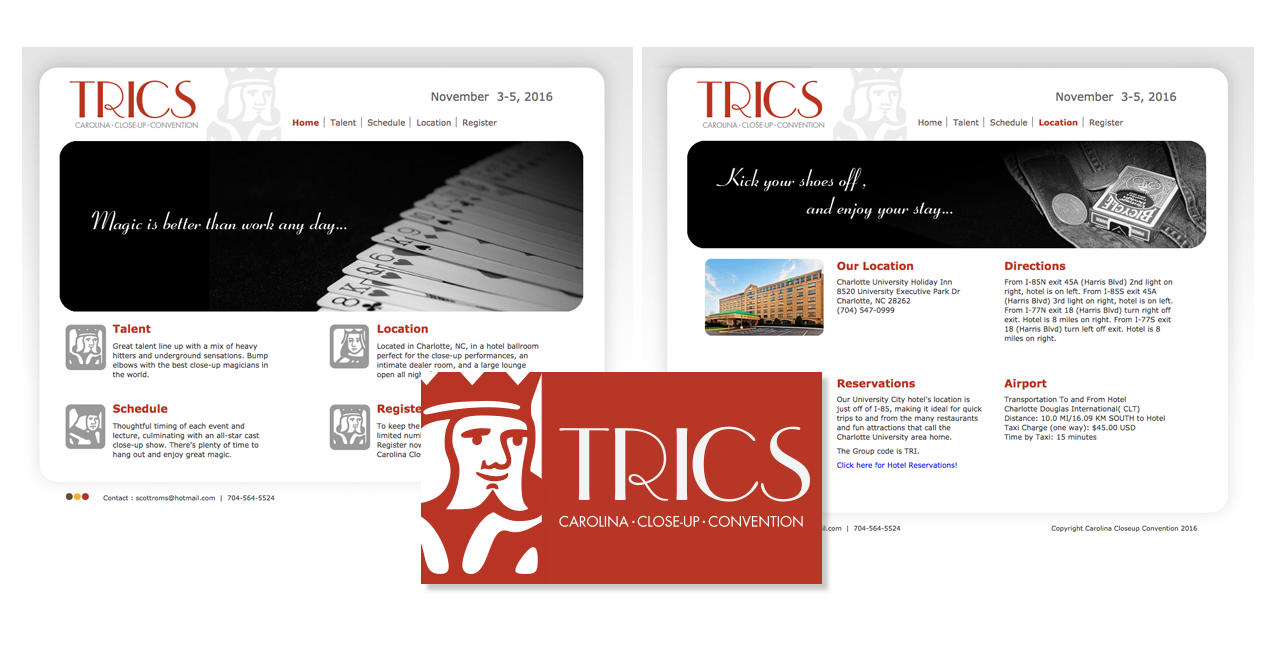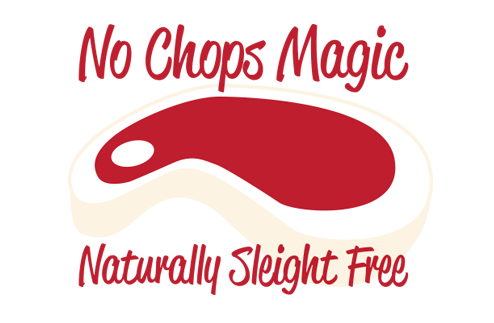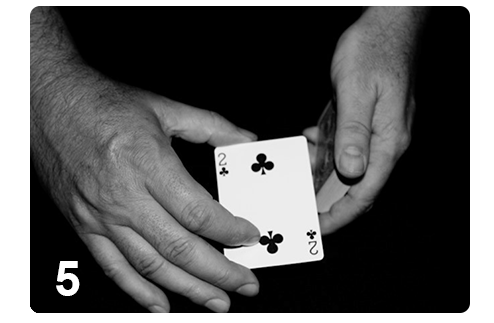MAGIC
A few secrets revealedNights at the Round Table
Designs for the Sleight Club brand and books

TRICS Convention

Super Duper Card
This one card replaces a fistful of other gimmicks. Simple construction. Easy to handle. 100% fat free…
There are several cards similar to this one, but the engine in this one is just a little different. Parts are cheap. You can customize the tension. Use elastic thread (McBride Kundaline Rising). It has the just the right strength.
You will need to build the gimmick card.
• Elastic thread (6 inches total)
• Clear extra strength mail tape
• Two playing cards
Step 1
Tape two cards together to form a card wallet. Fold closed to create a single (double) card. Tape on the inside so the sticky side is on the card. You can do it with two double backers as well to create a double double backer.
Step 2
Now the elastic thread. Mark off 2.5 inches on a piece of thread. Leave a ¼ inch on both sides to attach to the tape. Just the middle section needs to be exact. This length creates the right tension. Tape to inside of the card just below the border. This is the main thread and tension can be adjusted by going shorter or longer. This tension works for the weight of the deck to prohibit launching.
Step 3
Create a guide thread. Your card will now work but the elastic will hang out like a tongue after it shoots the card out. Cut a piece of elastic to use as a guideline to hold the other main thread inside the double card. This makes sure all the thread stays inside the card.

Load a card into the SDC using tilt. Simply raise the top card. The card can be loaded at either end with tilt. Just thumb count the top card and replace into the SDC from the front. Pressure will keep the card from releasing out the gimmick till you’re ready. To control the direction use your fingers and pressure to direct the card. It will shoot out sideways sometimes. Guide it with your grip.
Thick Card
Your SDC is a double card so it can now be used as a key card. It’s double thickness makes it perfect for cutting to or placing as a key card. (See Steve Bidwell for the real work.)
Double Backer
If your SDC is a double double backer you can use it in an ambitious routine to get a free double turn over with no guilt. Cutting it back to the top is easy.
Loading and Releasing Switch-a-Roo
Load the SDC with a card to be switched and have a card selected shown and put back into the deck sticking half way out. Turn wrist down and release pressure on the pack and the card will jump into your hand while you push the other card flush. Appears you’ve just removed the card from the deck. Switch more then one card.
(See Nestor Hato for the real work.)
Big Bullet
The big bullet trick. You know you love it. Have any card selected and returned and loaded into the SDC. Create the gun with a faro. The selected card is in the SDC at the end of the faro or barrel. Load the big bullet into the chamber the gun doesn’t fire until you release pressure on the SDC to shoot it out. Takes a few shots to get maximum distance.
Rising Card
The SDC is excellent for the standard rising card effects. It works best in hand. If you want to use it in card case remove a few extra cards from the deck. It can be very aggressive and jump out of the pack if you like.
The Card that Selects You
“Ever have a card select you?” Load the card to be forced in the SDC and place ¾ of the deck on top of it. Place the deck on the table. The card will remain until you lift off about half of the deck. Have the spectator lift the top half of the. The card will shoot across the table. Great force.
Effect: The card trick that fooled Houdini is recreated to show that Houdini was a bit of a douche. He claimed if he saw a trick three times he could tell the method. Jeez really. Not that big of a claim by todays standards.
You will need
• 25 Double backers
• 26 Regular cards
• SDC card
Order from top down
2 DBs, 1 Regular, 23 DBs,1 SDC, 26 Regular

Phase One
Ambitious Card. Turn deck face up and select a card from the regular section for the spectator to sign with Houdini’s name. Show enough of the cards but don’t expose the double backers. Have the signed card shown around.
Turn the deck face down. You can now do as many rounds of ambiguous card as you like using the double backers. Just do double lifts with the double backers. Slide the double backer into the top half as you return it so it stays in the top block. Next do a double backer double turn over.
On the third round show the Houdini card and flip up the regular card(See setup) on the top of the deck. Do a double turn over with this and you now have a double backer on top. Do a double turn over with the Houdini card and place it back into the middle. You now show the Houdini card has come back to the top. Then show the original top card is still there. This is a neat move don’t over look it.
Phase Two
Easy Triumph. Place the Houdini card face down in the top portion of the deck (All double backers). Turn the deck face up to show it is near the middle. Turn the deck face down and push the card flush. Very fair. Now cut the deck right at the SDC using a charlier cut. This divides the cards into regular and double backers. You can now flip the regular cards face up and shuffle them into the doubles and it really looks shuffled. Give them a few overhand shuffles to emphasis there really are mixed. Just turn the deck face down spread them and only the Houdini card is face up.
Phase Three
More Ambitious. If you like you can do a few more rounds of the ambitious card trick that fooled Houdini. Hey, they said it went on for a while.
Phase Four
Houdini gets his revenge or does he prove he was a douche. Hand out the Houdini card and locate the SDC bringing it to the top. Load the Houdini card into the SDC and cut it close to the bottom. (See Card that Selects You.)
“Houdini would not be overshadowed.” At the right moment he reached over and lifted the deck and his card shot out as if by magic. You make the call, Triumph for Vernon or was Houdini a Douche…
It’s a true trick deck. Add additional gimmicks to the deck. Let’s face it, you’re not handing this deck out any way…
This routine was based on a Don England effect from his Six Pack DVD titled “Top or Bottom”. This effect was worked and reworked in Sleight Club sessions over several months. Scott Robinson added several touches that streamlined the effect and removed as many moves as possible. The outcome is a fun fast paced effect that is visually appealing.
Effect
A selected card jumps to the top or the bottom of the deck based on where the spectator would like it.
This is a three-phase routine with any number of changes based on how the performer likes to present the choices. The card or the deck can change their orientation on request.

Sleights: Double lift, tilt and block push off.
Setup: Reverse two cards on the bottom of the deck before the trick starts or use a half-pass while you are talking before the trick.
Start: Spread the cards face down and have a spectator select a card. Obviously don’t let them see the two cards reversed on the bottom. Ask the spectator to look at and remember their card. While they do this you are going to turn the deck over so the two face down bottom cards are on the top. You can do this all in one motion. (Photo 1) After they take the card you close the fan and rotate the deck ninety degrees and as your hands come together then you just rotate it over. The deck is now in left hand dealing position ready to get into the tilt position. This all happens while the spectator is looking at their card or showing it to friends. This is very easy to do and almost happens naturally.
Phase 1: Have the spectator hand you the card and place it second from top using tilt. The deck now has three face down cards on top with the rest of the deck face up. It appears as if you have just placed their card in the middle of the deck face down. Be careful not to flash the bottom of the deck with a back showing. (Photo2)
“This card trick will do anything you ask it to do. Where would you like your card to appear on top or bottom?”
As you say this casually thumb off the first two cards of the deck being careful not to expose the face up portion of the deck. During this display get a little finger break under the second card in preparation to perform a double lift. (Photo 3)
If the spectator replies “On the top” I always reply “Oh so you like it on top!”
Hopefully you’ll get a good chuckle. Perform a double lift and show them their card has jumped to the top.
If they reply “On the bottom” you perform the double and reply “There it is on the bottom.” Of course they don’t get it until you spread the cards doing a block pushoff so you don’t expose the face down third card. You can now spread the deck showing all the cards have reversed themselves and their card is actually on the bottom. (Photo 4)
Phase 2: Close the deck now in left hand dealing grip and relax. Reach down with your right hand and lift a double in biddle grip. This should be easy since the third card is reversed. Holding the double face up with the selection showing drop your left hand to your side casually. (Photo 5) Call attention to the selection (Double) and bring your left hand up to the card. The deck appears to be face down. In reality the deck has one card face down the rest of the deck face up. Replace the double on the deck and turn it face down. Now say “Where would you like the card to appear on top, which I know you like, or on the bottom?”
As you say on the bottom remove the top card and slide it to the bottom with a wink. If they say on the top simply turn over the top card and show it’s jumped to the top.
“I know you like it on the top!”
If they say on the bottom turn over the top card and spread the deck pushing over the top two cards as one and show that the deck has reversed itself again. Remember the bottom card is face down so you can’t show the last card. (Photo 6)
Phase 3: Relax again and reach down with your right hand and lift of the top card letting your left hand fall to your side casually. Show the single card and raise your left hand again. The deck now has a face down card on top the rest of the deck face up and the bottom card is face down. You can now show the bottom of the deck.
Hold the deck up and say, “I know you like it on top but do you like it face up or face down?”
Which ever they say put the selection out jogged face down in the middle of the deck. If they said face up, flip the entire deck over. It appears the selection is face up in a face up deck. Or if they say face down they all appear to be face down. (Photo 7) You have two potential revelations. One if face up and the other if face down.
Then say “Would you like your friends to be face up or face down? “
If the cards are face up they will almost always say face down. Remove the bottom card which will be face up and place it face down the top of the deck. Spread the cards pushing the two top cards as one and all the cards will appear to reverse themselves and only the selection will be face up. If they say face down leave the deck face down flashing the bottom card so it appears the card is face down in a face down deck. Ask them the same question about their friends and move the face down (Photo 8) card to the top turning it face up. Spread the cards and all the cards will be face up with the selection face down.








